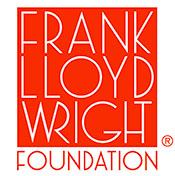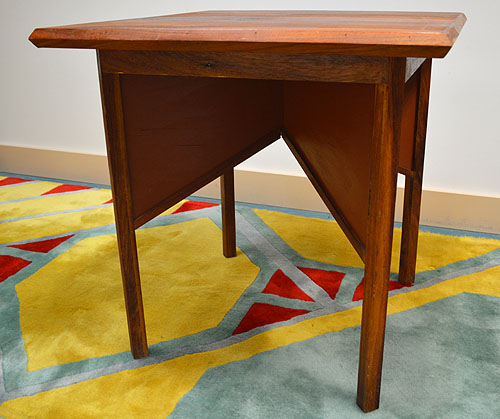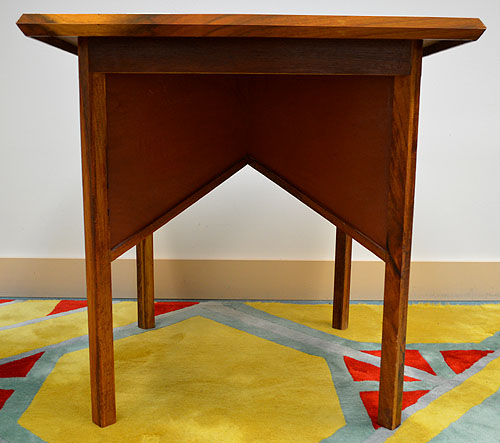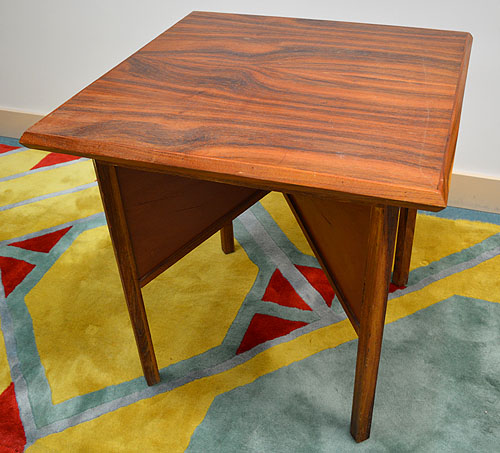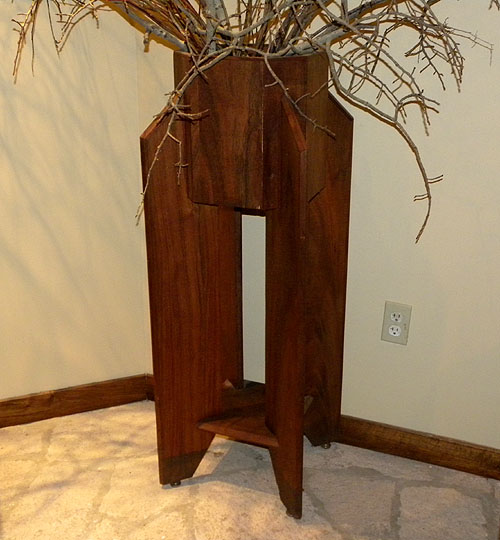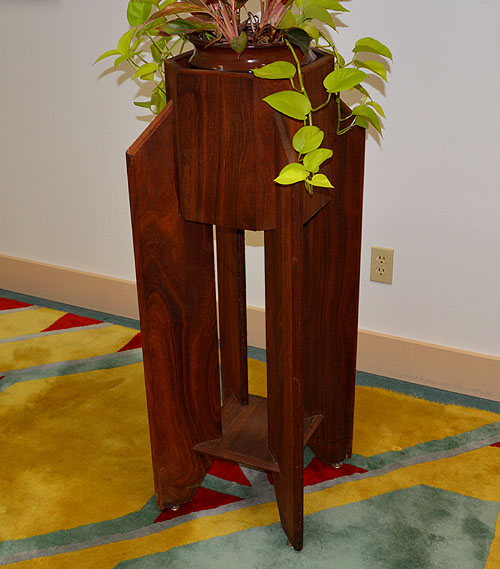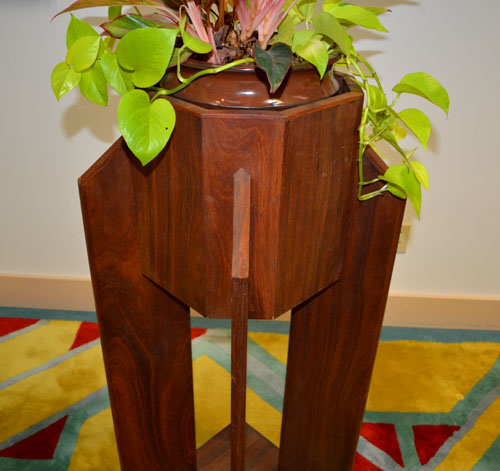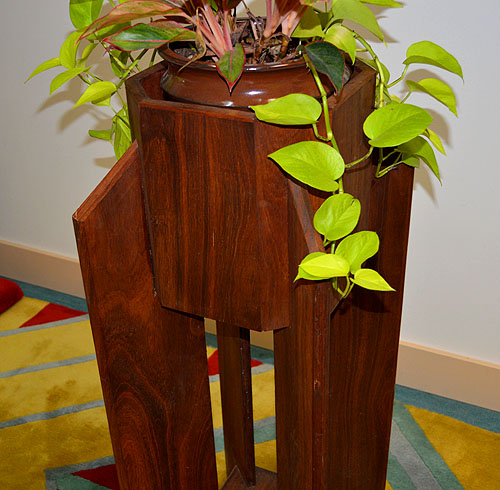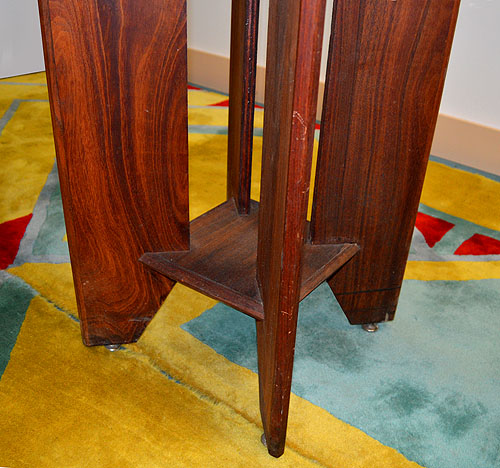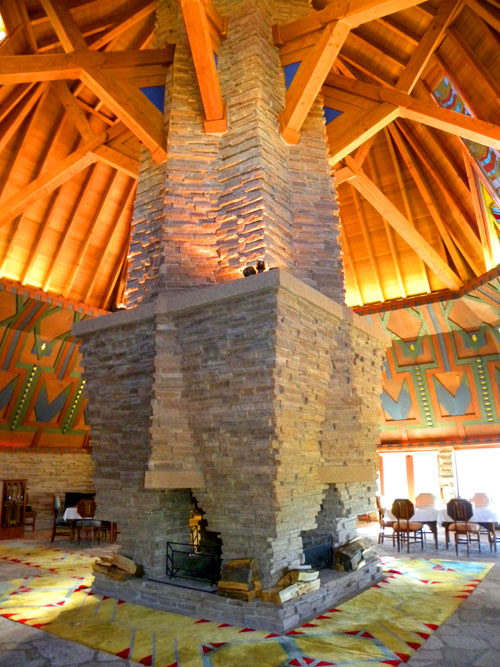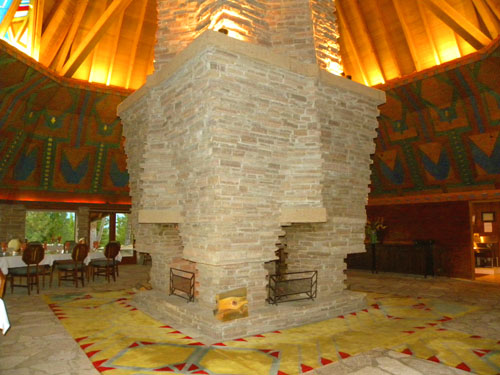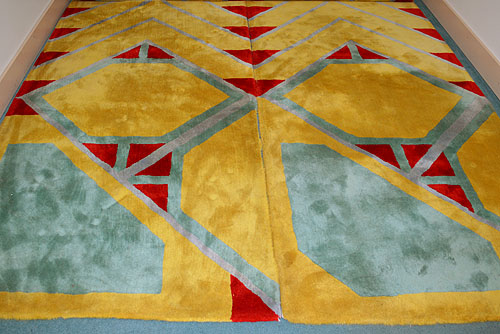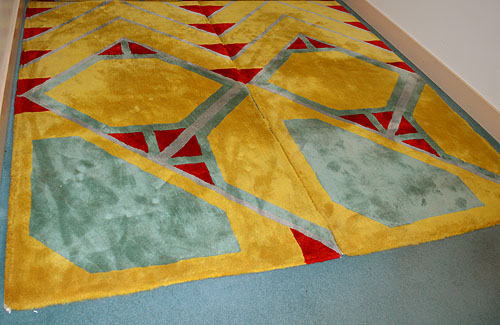|
|
|
|
|
|
|
Nakoma
Clubhouse. Nakoma
Clubhouse Furniture and Fabric. Road Trip. During the
beginning of June, 2015, we were notified that the Nakoma
Golf Resort in Clio, California, was retiring and selling
off the original furniture designed by John Rattenbury and
the Taliesin Architects in 2001. Like the collaboration
between Frank Lloyd Wright and George
Niedecken
during the beginning of the nineteenth century, Rattenburg
was an apprentice and worked closely with Wright. John
Rattenbury became a member of the Taliesin Fellowship in
1950, worked with Frank Lloyd Wright for nearly a decade. He
worked on 60 of Wrights projects, including the Guggenheim
Museum, the Gammage Auditorium and the Marin County Civic
Center.
In 1959, Frank Lloyd Wright designed the
Lykes Residence, his last
residential work. As John Rattenbury describes it, "After
studying the topographic map, Wright set it aside for a
while and worked on other projects. He always allowed an
idea to germinate before committing to it to paper. The next
morning he quickly sketched a plan on the map... With a
panoramic view in mind, and considering the shape of the
natural plateau, he drew two overlapping circles... After a
while, Wright got up from his desk and walked out of the
studio. He never returned. The next day he was in the
hospital with an intestinal problem..."
A Living Architecture, Rattenbury, 2000, p.247-250. Working drawings
were completed in 1966 by Rattenbury, who had worked closely
with Mr. Wright on the initial plans and supervised the
construction of the home. He designed the furniture and
built-ins, adapted from the original plans created by Wright
before his death.
A few notable projects he was lead
architect on, were the Mesa Community Center, 1980; Arizona
Biltmore expansion, 1987; The Phoenix Zoo Masterplan, 1987;
Lewis and Roca Law Offices, Phoenix, 1990; Wailapu Valley
Country Club (Marilyn Monroeís House), Maui, 1994; Lykes
Remodel, 1995. Just to |
|
name a few. In
1997, he was selected to design the new Life Dream House
which was eventually built at the Nakoma Golf community.
In 1995, Dariel and Peggy Garner contacted
the Frank Lloyd Wright Foundation and began working with the
Taliesin Architects in 1995. During a planning meeting they
were shown the original Nakoma clubhouse plans. Arnold Roy
was the Architect, Rattenbury oversaw all the interior
designs and details, including the furniture, art glass
windows, custom hand-knotted carpets from China, even the
dining room place settings, adapting the design, as he did
for the Lykes Residence, from Wrightís original plans. For
the upholster, he selected Schumacherís "Imperial Triangle,"
teal, beige and ivory, which was first manufactured in 1986,
but is reminiscent of "Design No. 705," Schumacher/Wright,
1955. Dedication ceremonies for the completed clubhouse were
held in May, 2001.
John Rattenbury worked with the Taliesin
Architects until 2003.
Upon hearing that Nakoma was retiring the
original furniture, we contacted them to save and preserve
one example of each of the pieces Rattenbury had designed.
We rented a uhaul trailer, and my son, grand daughter and
myself left on a road trip from Seattle to Clio, California.
We made one stop in Redding California, where the kind
people at the Pilgrim Congregational Church (1958 - S.431)
allowed us to tour and photograph their church, inside and
out.
We were able to acquire examples of the
barrel chairs, dining room chairs, small, medium and large
tables, a plant stand, three bolts of Schumacher fabric and
two pieces of the hand-made carpet that surrounded the
fireplace in the Dining Room. We were not able to acquire an
example of the coffee table. 2001.68 (1-27)
(Updated March 2016) |
|
|
|
|
|
|
|
|
|
SCHUMACHER FABRIC
BARREL CHAIR
DINING ROOM CHAIR
LARGE TABLE
MEDIUM TABLE
SMALL TABLE
PLANT STAND
CARPET
COFFEE TABLE
NAKOMA CLUBHOUSE STUDY |
|
|
|
|
|
|
|
|
| |
|
Schumacher's
1955 "Imperial Triangle fabric was "adapted by Mr. Wright
from an upholstery fabric for the Imperial Hotel..."
Frank Lloyd Wright,
Decorative Designs Collection, 1990, page 17.
"Various fabrics and rugs were especially designed to
complete the unity of the Imperial Hotel... A section (plate
14) is one of three samples to have been preserved at
Taliesin. As in the Midway Gardens murals, the design is
based on disks and overlapping circles."
The Decorative Designs
of Frank Lloyd Wright, Hanks, 1979, p.132 (plate 14
is example 1 below). Examples 2-5 below appear to use the
fabric from example on below, plate 14. The fabric in
example 6 below appears to lack the "circle design."
The Nakoma
Clubhouse chairs were upholstered in
Schumacherís "Imperial Triangle," teal, beige (rose) and
ivory. It was first manufactured in 1986, and is reminiscent
of "Design No. 705," Schumacher/ Wright, 1955. In 1955,
Schumacher, in collaboration with Frank Lloyd Wright,
produced
"Schumacherís Taliesin Line of Decorative Fabrics and
Wallpaper" sample book. Design No. 705 Fabric Samples
included Champagne, Willow Green, Gold, Pink, Turquoise,
Granite and Tan. Matching wallpaper was available. In 1987,
Schumacher, working with the Frank Lloyd Wright foundation,
produced
"Frank Lloyd Wright,
A collection of Wallcoverings, Companion Fabrics and
Borders" sample book. Colors included Taupe (warm
beige), Pewter, Seafoam (ivory with light green triangles),
Tan and Copper. Although there was matching fabric and
borders, the design was different. Photographs of "Liberty
Weave" appeared in the earlier "Frank Lloyd Wright:
Schumacher" 1886, there were no fabric samples of it in
1987. Three bolts of fabric, 56" wide, teal, beige (rose)
and ivory.
(ST#2001.68:25-27) |
| |
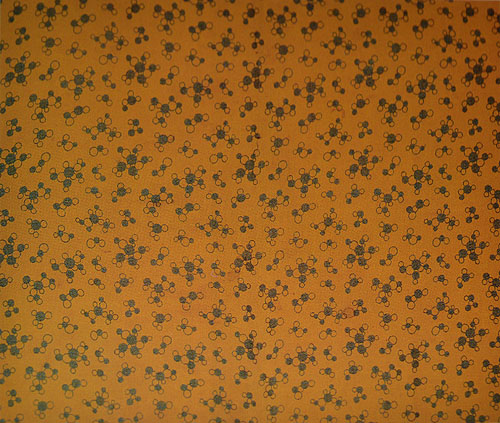 |
| 1) Example
of fabric from the Imperial Hotel, 1916. "Various fabrics
and rugs were especially designed to complete the unity of
the Imperial Hotel... A section (plate 14) is one of three
samples to have been preserved at Taliesin. As in the Midway
Gardens murals, the design is based on disks and overlapping
circles." The
Decorative Designs of Frank Lloyd Wright, Hanks, 1979,
p.132. Photo courtesy of The Decorative Designs of Frank
Lloyd Wright. |
| |
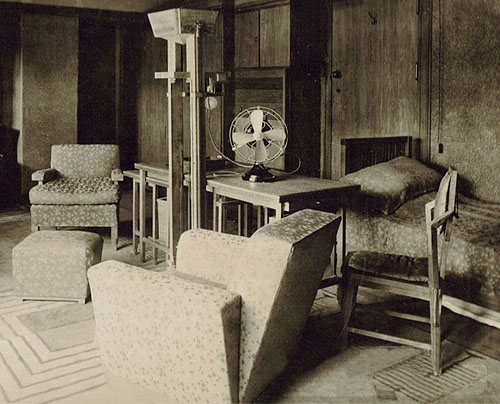 |
|
2) Imperial Hotel, Tokyo, 1923.
Photograph detail of the 1923 real photo
postcard. View of bedroom. Besides the single bed with the prairie
styled headboard, there are three chair variations, a
hassock and two tables. The seat of the chair on the right is square, the back is shaped as a
hexagon. Two pads are held in place by ties that are fed through the frame
to the back side and match the patterned fabric used throughout
the room. The two armchairs and hassock are upholstered with matching
fabric, as is the bedspread and pillow cover. |
|
|
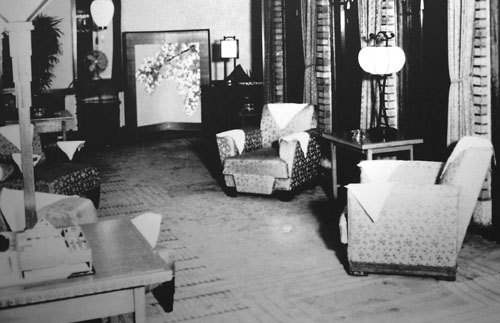 |
|
3) Imperial Hotel, Tokyo, 1923.
Photograph detail of the 1923 photograph.
View of possibly a bedroom suite sitting room. There are three
side tables, two variations of arm chairs, one floor lamp and
the carpet designed by Frank Lloyd Wright. The
armchairs are upholstered with the patterned fabric.
|
|
|
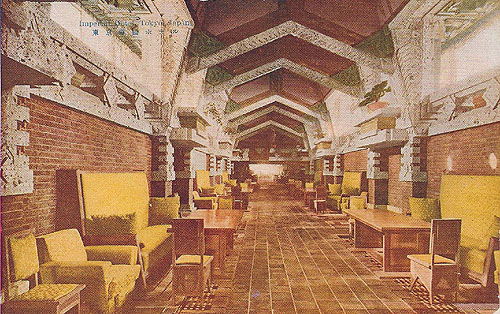 |
|
4) Imperial Hotel, Tokyo, Circa 1923.
1923 postcard.
Furniture appears to be upholstered in a yellow patterned
fabric. View of the Promenade, which was later called
"Peacock Alley". When facing the Imperial Hotel, this ran
between the two long outside bedroom wings on the second
floor toward the rear of the hotel. This view was from the
outside looking toward the center. This early postcard shows
the interior color scheme of the Imperial Hotel as Wright
intended it. |
|
|
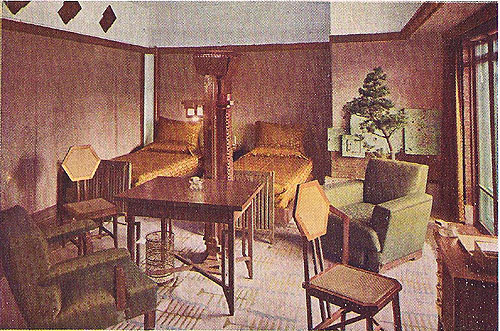 |
|
5) Imperial Hotel, Tokyo,
Circa 1930. Photograph from a
1930 booklet.
View of a bedroom. Armchairs appear to be upholstered in a green
patterned fabric and the beds appear to be covered
in a yellow patterned fabric. |
|
|
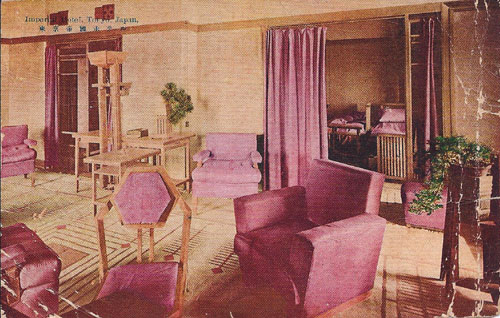 |
|
6) Imperial Hotel, Tokyo,
Circa 1923.
1923 postcard.
View of a bedroom suite. Furniture appears to be upholstered in
a plain fabric. |
|
|
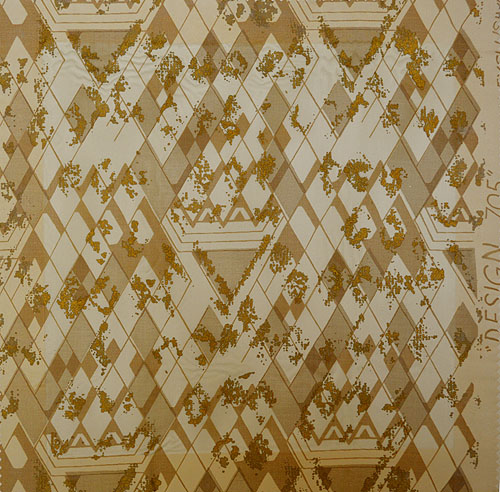 |
|
7) Schumacher Fabric "Design No. 705," Champagne. In
1955, Schumacher, in collaboration with Frank Lloyd Wright,
produced "Schumacherís
Taliesin Line of Decorative Fabrics and Wallpaper"
sample book. Design No. 705 Fabric Samples included
Champagne, Willow Green, Gold, Pink, Turquoise, Granite and
Tan. Matching wallpaper was available. |
| |
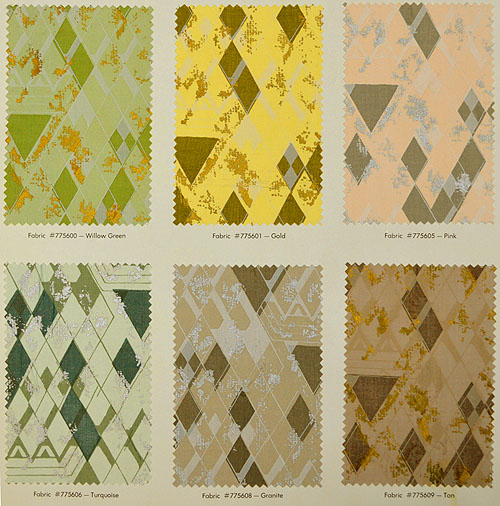 |
|
8) Schumacher Fabric "Design No. 705." Top row (L to
R): Willow Green, Gold, Pink. Bottom row (L to R):
Turquoise, Granite and Tan.
"Schumacherís Taliesin
Line of Decorative Fabrics and Wallpaper" |
| |
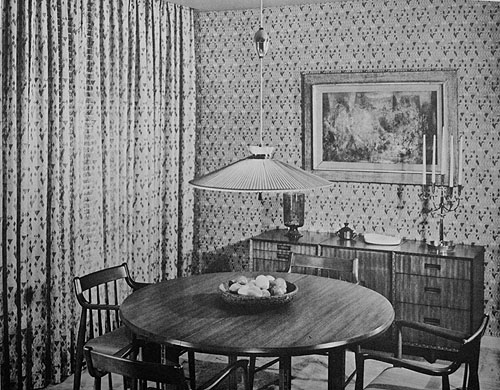 |
|
9) Schumacher/Heritage-Henredon Dining Room 1955.
This is a copy of the photograph published in the "Schumacherís
Taliesin Line of Decorative Fabrics and Wallpaper,"
Schumacher/Wright, 1955, as an example of "Design No. 705"
fabric and wallpaper. A similar design was used in 2001 at
the Nakoma Clubhouse, Cleo,
CA. The furniture was produced by Heritage-Henredon,
designed by Frank Lloyd Wright. The buffet cabinet in the
background is a combination of three small chests, No. 2002
(L), 2003 and 2001 (R). The table appears to be possibly a
prototype of the dining room tables to come. The legs are
correct, with the bullnose outer edge and carved patterned
design. The round table top has the bullnose edge, but no
design. To date, we have seen rectangular table tops as well
as other furniture with the decorative design, but the round
table tops, No. 2000 and 2001, are trimmed with copper
moulding. The chairs do not appear to be designed by Wright,
and were possibly used due to the lack of samples at the
time. There is a note in House Beautiful, November, 1955,
p.282 which might shed some light in explaining the
discrepancies. "Much of this merchandise was not available
for photograph as this issue went to press..." (Thanks to
Peter Kelley,
MassModern for his insight.) |
| |
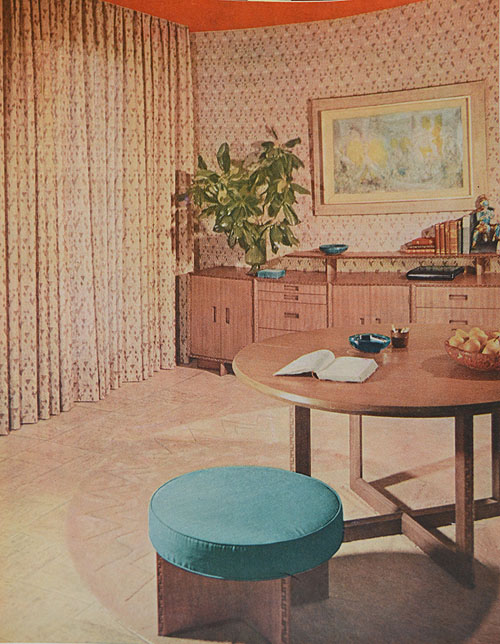 |
10) Schumacher/Heritage-Henredon
Dining Room 1955. This is a copy of the photograph published in
House
Beautiful, November, 1955, p.283. Drapes and wallpaper are
"Design No. 705", "Schumacherís Taliesin Line of Decorative
Fabrics and Wallpaper," Schumacher/Wright, 1955, fabric and
wallpaper. A similar design was used in 2001 at the
Nakoma Clubhouse, Cleo, CA. The
furniture was produced by Heritage-Henredon, designed by Frank
Lloyd Wright. The buffet cabinet in the background is a
combination of four small chests (L to R), No. 2003, 2002, 2003
and 2001. The shelf was an optional add-on. The table appears to
be possibly a prototype of the dining room tables to come. The
legs are correct, with the bullnose outer edge and carved
patterned design. The round table top has the bullnose edge, but
no design. To date, we have seen rectangular table tops as well
as other furniture with the decorative design, but the round
table tops, No. 2000 and 2001, are trimmed with copper moulding.
The bench is No. 1904. There is a note in House Beautiful,
November, 1955, p.282 which might shed some light in explaining
the discrepancies. "Much of this merchandise was not available
for photograph as this issue went to press..." (Thanks to
Peter Kelley, MassModern
for his insight.) |
| |
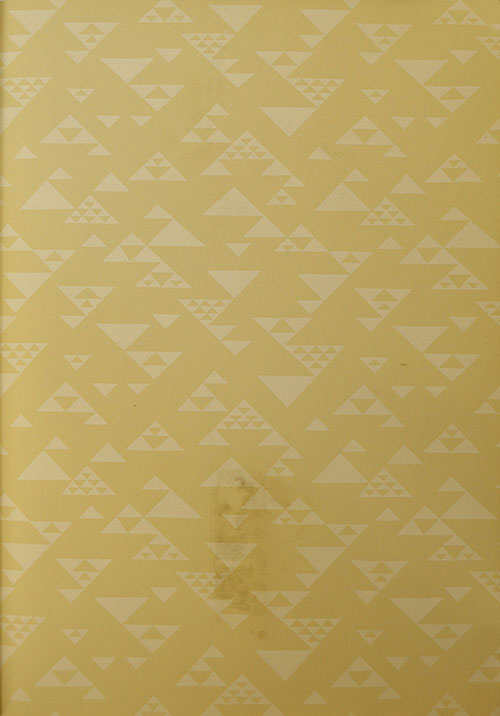 |
|
11) Schumacher Wallpaper sample Taupe (warm beige).
In 1987, Schumacher, working with the Frank Lloyd Wright
Foundation, produced
"Frank Lloyd Wright,
A collection of Wallcoverings, Companion Fabrics and
Borders" sample book. Colors included Taupe (warm
beige), Pewter, Seafoam (ivory with light green triangles),
Tan and Copper. |
| |
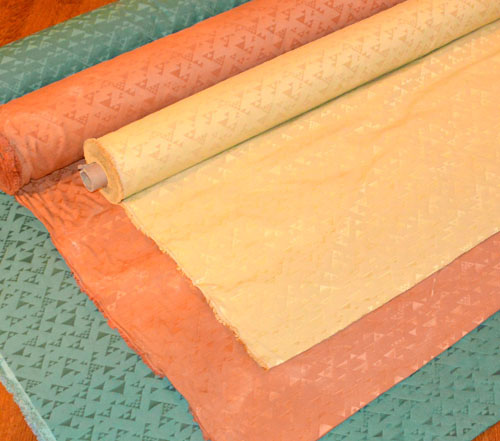 |
|
12) Schumacher Fabric. The Nakoma Clubhouse
chairs were upholstered in Schumacherís "Imperial Triangle,"
teal, beige (rose) and ivory. Three bolts of fabric, 56" wide, teal, beige (rose)
and ivory. |
| |
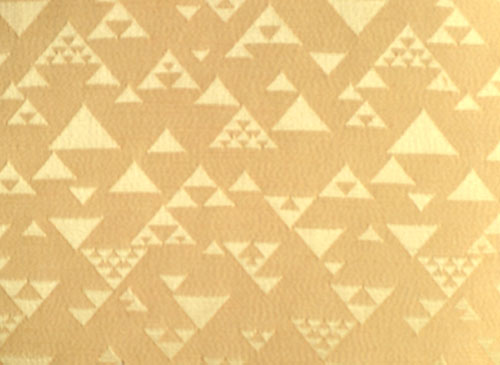 |
|
13) Sample of Schumacher "Imperial Triangle"
ivory. |
| |
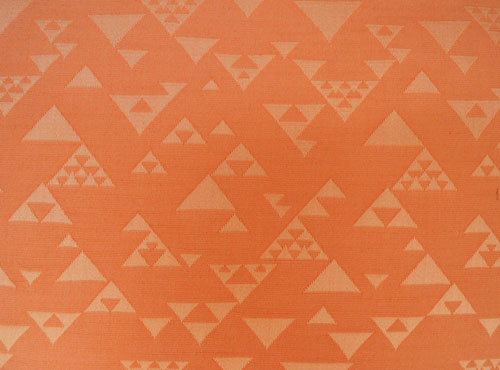 |
|
14) Sample of Schumacher "Imperial Triangle"
beige (rose). |
| |
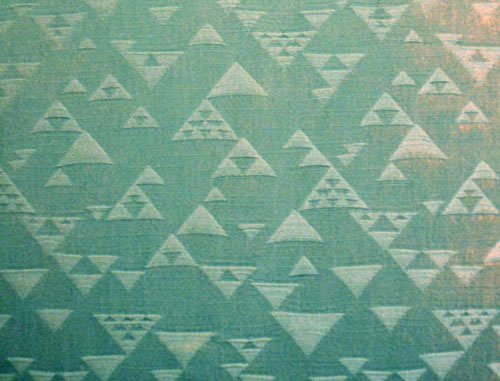 |
|
15) Sample of Schumacher "Imperial Triangle"
Teal. |
| |
| |
| |
|
|
|
| |
|
Nakoma Clubhouse Barrel Chair, 2001. 27.5" wide x
27.5" deep x 28.5" high. "What we need today is that
art shall have a new direction and artists consider
the possibilities of an easy chair or the fireplace
quite as important as the house itself or the
picture on its walls, to the end that everything may
contribute to easy utility and quiet beauty to the
end, for it is not in itself that a thing is chiefly
beautiful but in its relationships." ó Frank Lloyd
Wright, "Art in the Home." Arts for America, June,
1898, p.581. Frank Lloyd Wright first designed the
barrel chair for the Darwin Martin Residence (1904).
In 1905, he designed a barrel chair for the Frank L.
Smith Bank. Slight modifications were made to the
Martin design for the H. F. Johnson Jr. Residence,
Wingspread (1937). He liked the design so much that
when the order was placed for Johnson, he ordered a
dozen for Taliesin. Constructed of solid wood and
plywood, the design of the Nakoma barrel chairs
utilizes five sides of the octagon. Chairs were
upholstered in Schumacherís "Imperial Triangle,"
Teal, Beige (Rose) and Ivory. It was first
manufactured in 1986, and is reminiscent of "Design
No. 705," Schumacher/ Wright, 1955. Chairs were also
upholstered in "Liberty Weave," Schumacher Series
89690 (1986) and burgundy vinyl. We acquired four
barrel chairs, two in beige, two in vinyl.
(ST#2001.68:1-4) |
|
|
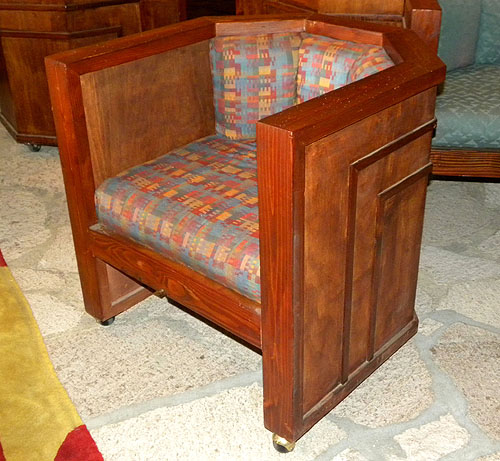 |
|
1) Nakoma barrel chairs upholstered in "Liberty
Weave" Schumacher Series 89690, photographed at the
Nakoma Clubhouse, 2012. |
|
|
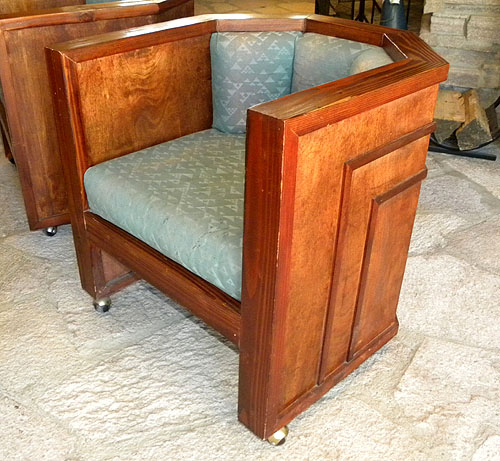 |
|
2) Nakoma barrel
chairs upholstered in Schumacher's "Liberty
Triangle," Teal, photographed at the Nakoma
Clubhouse, 2013. |
|
|
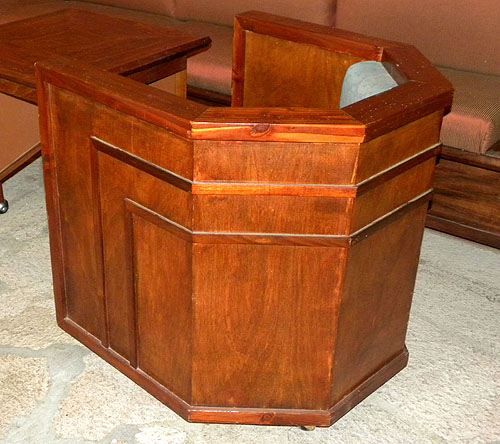 |
|
3) Nakoma barrel
chairs upholstered in Schumacher's "Liberty
Triangle," Teal, photographed at the Nakoma
Clubhouse, 2013. |
|
|
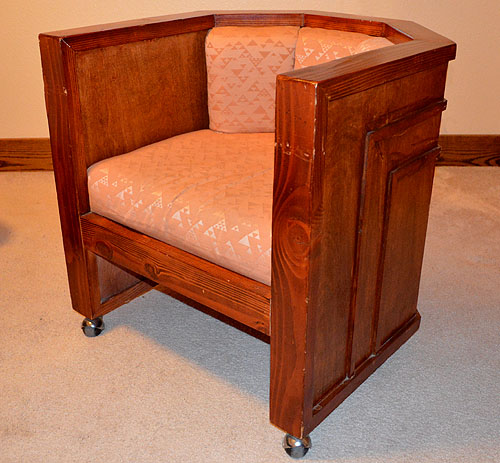 |
|
4) Nakoma barrel
chairs upholstered in Schumacher's "Liberty
Triangle," Beige (Rose), photographed in 2016. |
|
|
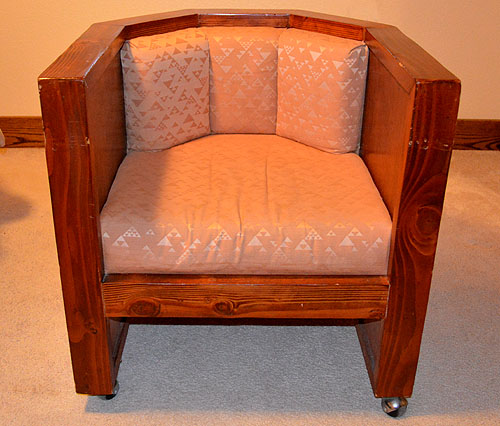 |
|
5) Nakoma barrel
chairs upholstered in Schumacher's "Liberty
Triangle," Beige (Rose), photographed in 2016. |
|
|
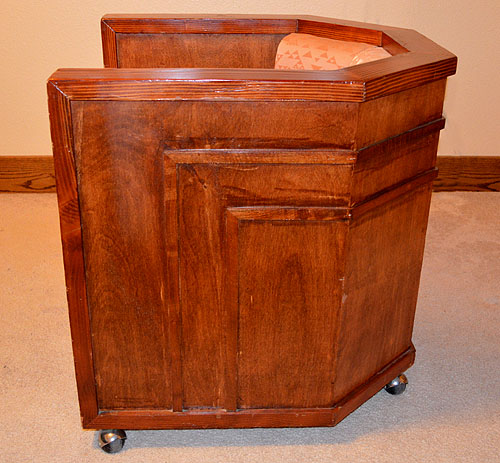 |
|
6) Nakoma barrel
chairs upholstered in Schumacher's "Liberty
Triangle," Beige (Rose), photographed in 2016. |
|
|
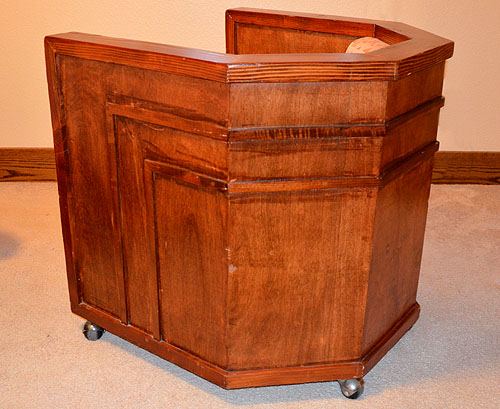 |
|
7) Nakoma barrel
chairs upholstered in Schumacher's "Liberty
Triangle," Beige (Rose), photographed in 2016. |
|
|
|
|
|
|
|
|
|
|
|
|
| |
|
Nakoma Clubhouse Dining Room Chair, 2001. 21" wide x
21" deep x 40" high. Constructed of solid wood and
plywood, Chairs repeat the octagon footprint of the
Nakoma Clubhouse "Wigwam." The shape of the wigwamís
clerestory art glass windows is inverted and
incorporated into the design on the back of the
chairs, and are accented with patinated copper
triangles. Chairs are upholstered in Schumacherís
"Imperial Triangle," teal, beige (Rose) and ivory.
It was first manufactured in 1986, and is
reminiscent of "Design No. 705," Schumacher/Wright,
1955. Fourteen chairs, eight ivory, three in beige,
three in teal. (ST#2001.68:5-18) |
|
|
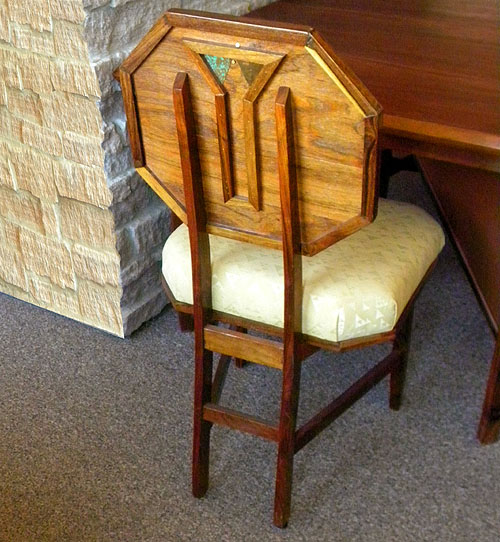 |
|
1) Nakoma dining room chairs upholstered in
Schumacher's "Liberty Triangle," Ivory, photographed
in the Members Dining Room at the Nakoma Clubhouse,
2012. |
| |
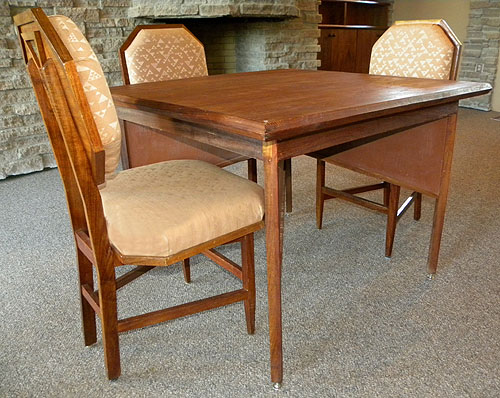 |
| 2) Nakoma
dining room table and three dining room chairs upholstered
in Schumacher's "Liberty Triangle," beige (rose),
photographed in the Members Dining Room at the Nakoma
Clubhouse, 2012. |
| |
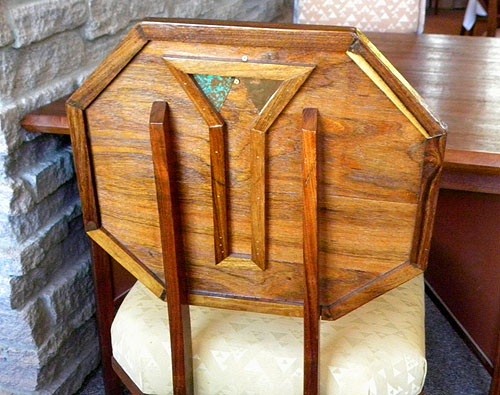 |
| 3) Nakoma
dining room chairs repeat the octagon footprint of the
wigwam. The shape of the wigwam clerestory art glass windows
is inverted and incorporated into the design on the back of
the chairs. |
| |
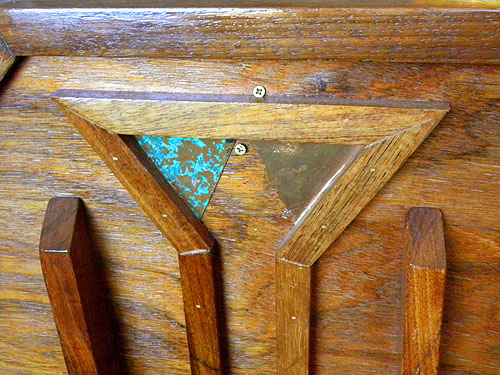 |
| 4) The
back of the Nakoma dining room chairs are accented with
patinated copper triangles. |
| |
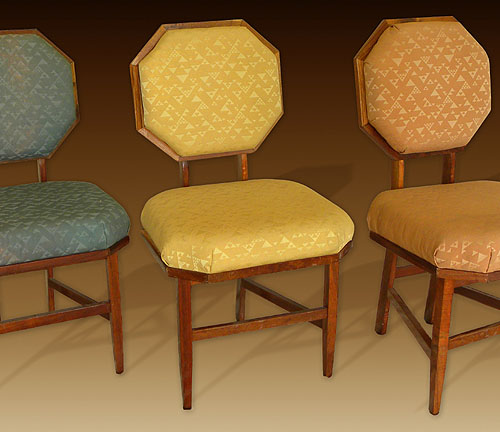 |
| 5) Chairs
are upholstered in Schumacherís "Imperial Triangle," teal,
ivory and beige (Rose). |
| |
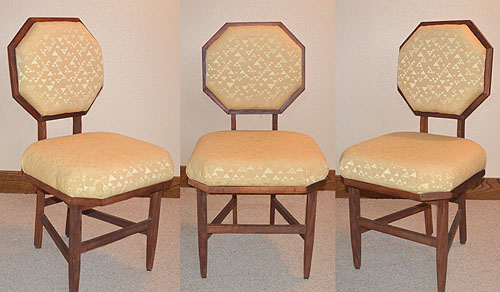 |
| 6) View of
he dining room chair from three views. |
| |
| |
| |
|
|
|
|
|
|
Nakoma
tables were produced in three sizes; Dining Room
(large); Lounge (Medium); and End Tables (Small).
Constructed of solid wood and plywood. The large and
medium table tops are constructed of a single sheet
of plywood, trimmed on all four sides. The smaller
table is created using four triangles, the tops meet
in the center, and trimmed on four sides. The Nakoma
table legs are not just legs, but a design that
masters space. Tables are very functional. Place
dining room table end to end, and you have an eight,
twelve or sixteen foot table. Nakoma Clubhouse Large
Dining Room Table, 2001. 42" wide x 42" deep x 30"
high. Medium Table, 2001. 30" wide x 30" deep x 30"
high. Small End Table, 2001. 22.5" wide x 22.5" deep
x 25" high. (ST#2001.68:19) |
| |
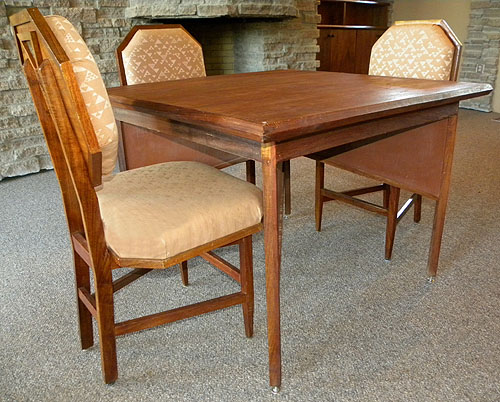 |
| 1) Nakoma
dining room table and three dining room chairs photographed
in the Members Dining Room at the Nakoma Clubhouse, 2012.
Large Dining Room Table, 2001. 42" wide x 42" deep x 30"
high. |
| |
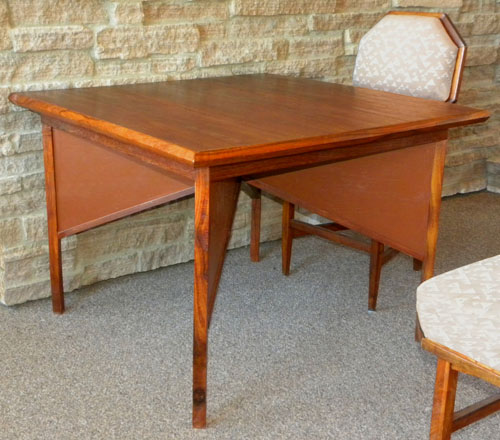 |
| 2) Nakoma
dining room table photographed in the Members Dining Room at
the Nakoma Clubhouse, 2012. Large Dining Room Table, 2001.
42" wide x 42" deep x 30" high. |
| |
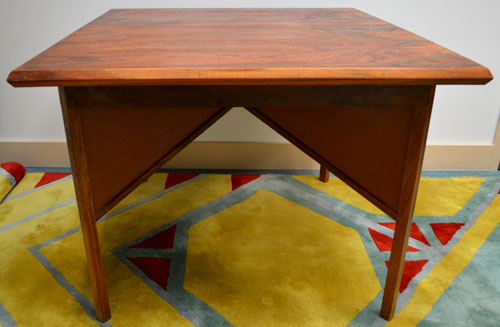 |
| 3) Nakoma
dining room table front view photographed in 2016. Large Dining Room Table,
2001. 42" wide x 42" deep x 30" high. |
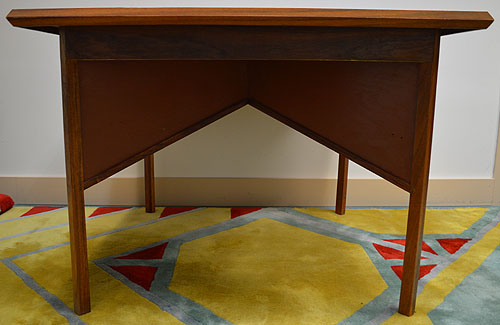 |
| 4) Nakoma
dining room table front view photographed in 2016. Large Dining Room Table,
2001. 42" wide x 42" deep x 30" high. |
| |
| |
|
|
|
|
|
|
|
|
|
|
|
|
Nakoma
tables were produced in three sizes; Dining Room
(large); Lounge (Medium); and End Tables (Small).
Small tables were also used in the Nineteenth Hole
Lounge. The smaller table top is created using four
triangles, the tops meet in the center, and trimmed
on four sides. Constructed of solid wood and
plywood. Small End Table, 2001. 22.5" wide x 22.5"
deep x 25" high. (ST#2001.68:21) |
| |
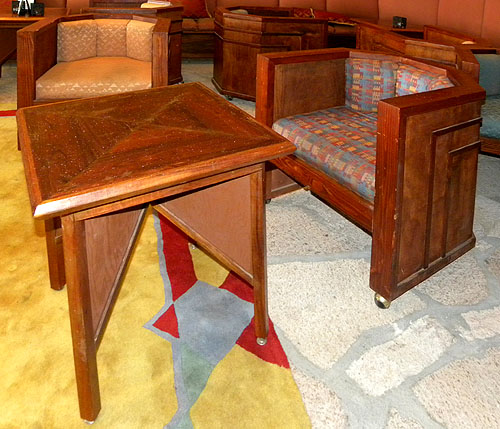 |
| 1) Nakoma
end table and two barrel chairs photographed in the
Nineteenth Hole Lounge at the Nakoma Clubhouse, 2012. Small
End Table, 2001. 22.5" wide x 22.5" deep x 25" high.
|
| |
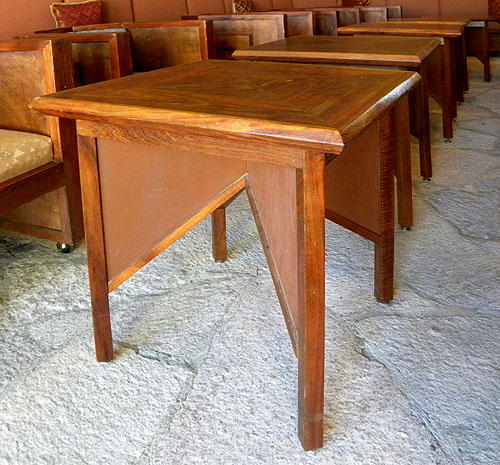 |
| 2) Nakoma
end tables photographed in the
Nineteenth Hole Lounge at the Nakoma Clubhouse, 2012. Small
End Table, 2001. 22.5" wide x 22.5" deep x 25" high. |
|
|
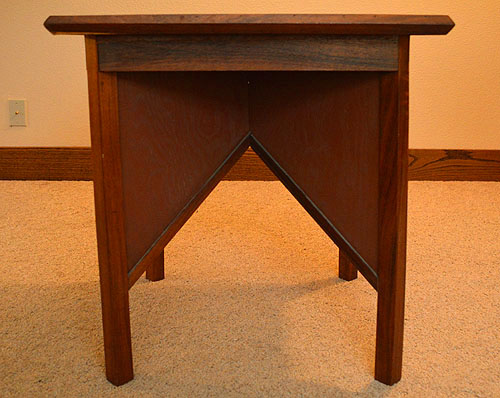 |
|
3) Nakoma end table front
view photographed in 2016. Small End Table, 2001. 22.5" wide
x 22.5" deep x 25" high. |
| |
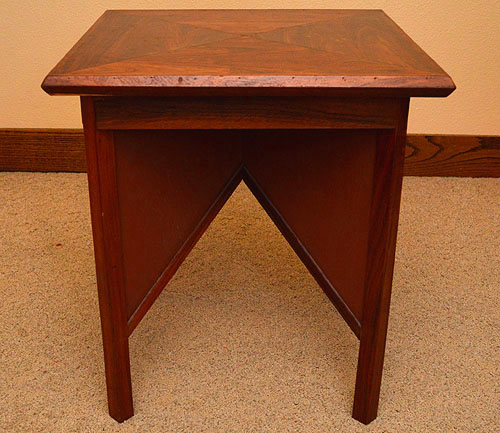 |
| 4) Nakoma
end table front view photographed in 2016. Small End Table,
2001. 22.5" wide x 22.5" deep x 25" high. |
| |
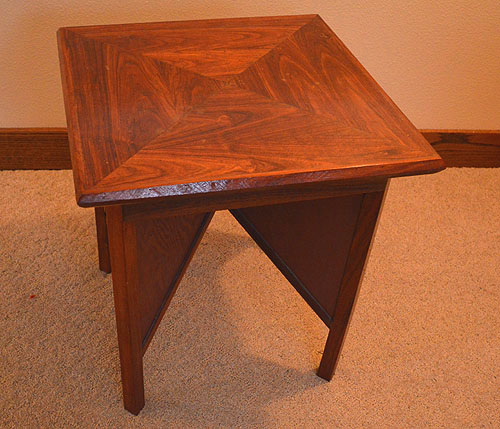 |
| 5) Nakoma
end table top view photographed in 2016. The smaller table
top is created using four triangles, the tops meet in the
center, trim added on four sides. Small End Table, 2001.
22.5" wide x 22.5" deep x 25" high. |
| |
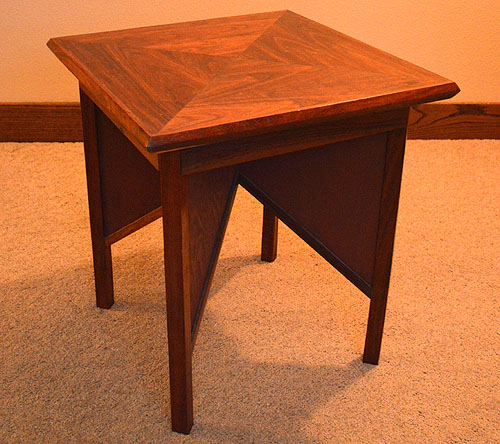 |
| 6) Nakoma
end table top view photographed in 2016. The smaller table
top is created using four triangles, the tops meet in the
center, trim added on four sides. Small End Table, 2001.
22.5" wide x 22.5" deep x 25" high. |
| |
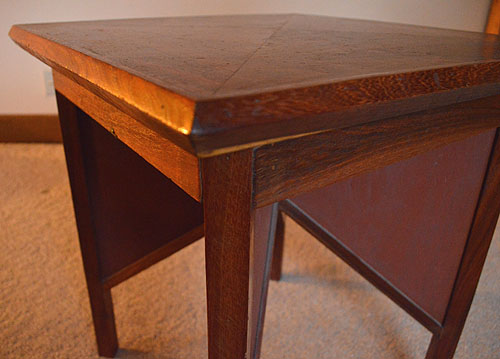 |
| 7) Detail
of the Nakoma end table photographed in 2016. The smaller
table top is created using four triangles, the tops meet in
the center, trim added on four sides. Small End Table, 2001.
22.5" wide x 22.5" deep x 25" high. |
| |
| |
| |
|
|
|
|
|
|
|
|
|
|
|
|
|
|
|
|
|
|
Nakoma Clubhouse Coffee Table, 2001. We attempted to
acquire an example of the coffee table that
coordinated with the rest of the Nakoma furniture,
but were unable to. |
| |
|
|
| |
|
|
BACK TO THE NAKOMA CLUBHOUSE STUDY |
|
|
|
Photographs
and text by Douglas M. Steiner, Copyright 2016. |
|
|
|
|
|
|

